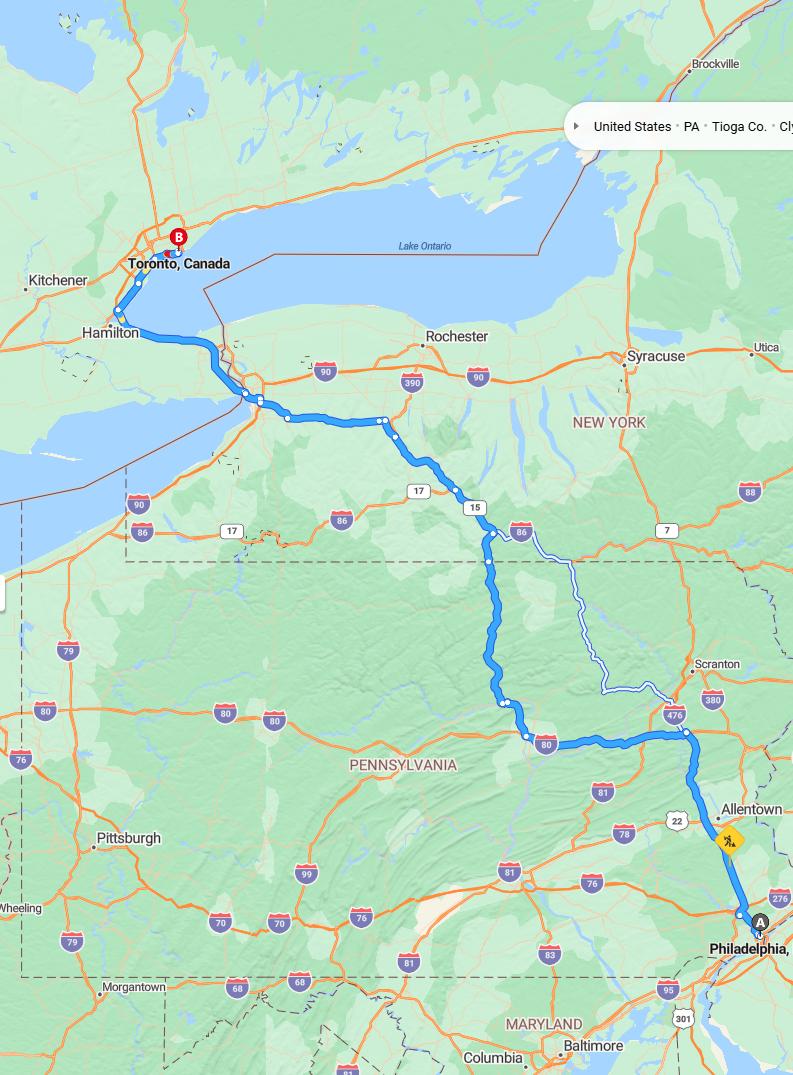Distance and estimated driving time
Driving from Philadelphia to Toronto typically takes approximately 7 hours and 58 minutes, covering a distance of about 472 miles. The optimal route includes traveling via I-476 N and US-15 N, ensuring a relatively direct connection between the two cities. This journey offers a mix of urban landscapes and scenic rural areas, making it a diverse road trip experience. Planning for potential stops and border crossing times can help in maintaining a smooth and enjoyable drive.
Driving route
Traveling from Philadelphia to Toronto offers a scenic and engaging journey through the northeastern United States and into Canada. Starting in Philadelphia, drivers pass through Allentown and Scranton, enjoying glimpses of historic sites and vibrant cityscapes. Continuing northward, the route takes travelers through Binghamton and Rochester, known for their cultural attractions and lush parks. As the journey progresses, the route crosses into Canada via Buffalo, leading directly into Toronto's bustling urban environment. This route provides a diverse mix of urban experiences, natural beauty, and regional highlights, making it an enriching trip for travelers.

Best departure times for avoiding traffic
For a smooth drive from Philadelphia to Toronto, it's best to depart early in the morning, ideally before 6:00 AM, to avoid peak traffic hours in major cities like Philadelphia and Allentown. Leaving later in the day, after 9:00 AM, can lead to increased congestion, especially around Allentown and Scranton, due to commuter traffic. Traveling during weekday mornings typically offers lighter traffic compared to late afternoons and evenings, making early departures more efficient. Planning your trip to arrive in Toronto before evening rush hour begins will help ensure a faster, more comfortable journey.
Border crossing procedures and documentation
When driving from Philadelphia to Toronto, travelers must pass through the U.S.-Canada border, which involves specific crossing procedures. Ensure you have valid travel documents, such as a passport or an appropriate biometric card, to facilitate quick entry into Canada. Customs officers may ask about the purpose of your visit, upcoming destinations, and carry any necessary visas if required. It's important to declare any goods or items being transported, comply with vehicle inspections, and be prepared for possible delays at the border crossing points along the route.
Toll costs and payment options
When driving from Philadelphia to Toronto, travelers will encounter several tolls along the route, particularly in New York State and the Pennsylvania Turnpike. Toll costs vary depending on the specific highways and vehicle type, with fees ranging from a few dollars to higher amounts for larger vehicles. Payment options are diverse, including electronic tolling systems like E-ZPass, which offer convenience and often discounted rates, as well as cash payments where accepted. Planning ahead with an electronic toll pass can help ensure a smooth journey and avoid delays at toll booths.
Recommended rest stops and accommodations
When driving from Philadelphia to Toronto, travelers should consider strategic rest stops to ensure a safe and comfortable journey. Popular rest areas include the Allentown Rest Area and the Binghamton Rest Stop, both offering convenient facilities for stretching and refueling. For overnight stays, Allentown and Rochester have a variety of hotels, from budget to premium, providing comfortable accommodations. Plan ahead by booking accommodations in advance near major cities like Scranton and Buffalo to avoid last-minute searches and enjoy a restful break during the trip.
Weather conditions and seasonal travel tips
Traveling from Philadelphia to Toronto, travelers should be prepared for varying weather conditions, especially during winter months, when snow and ice can impact driving safety. It is advisable to check local weather forecasts regularly and carry essentials such as snow chains, warm clothing, and emergency supplies. During spring and fall, unpredictable rain showers and changing temperatures require drivers to stay alert and maintain normal tire pressure for optimal traction. No matter the season, planning your route ahead of time and allowing for additional travel time can help ensure a safe and enjoyable journey through cities like Allentown, Scranton, and Buffalo.
Key attractions along the route
Traveling from Philadelphia to Toronto offers a variety of engaging attractions along the way. In Allentown, visitors can explore the vibrant local arts scene and historic sites such as the Allentown Art Museum. As you pass through Scranton, the Steamtown National Historic Site provides a fascinating glimpse into America's railroad history. Approaching Buffalo and Toronto, travelers can enjoy the scenic beauty of Niagara Falls, a world-renowned natural wonder, and explore cultural landmarks like the Museum of Science in Buffalo.
Vehicle maintenance tips for long drives
Embarking on a long drive from Philadelphia to Toronto requires thorough vehicle maintenance to ensure safety and reliability. Before the trip, check the tire pressure and tread depth, as well as the coolant, oil, and brake fluid levels, to prevent breakdowns. It's also essential to inspect the brakes, lights, and windshield wipers for optimal performance amidst varying weather conditions. Carrying a roadside emergency kit and planning regular rest stops can help manage fatigue and address any unforeseen vehicle issues along the route.
Safety precautions and travel advisories
When traveling from Philadelphia to Toronto, it is essential to prioritize safety precautions and stay informed about current travel advisories. Ensure your vehicle is well-maintained, and carry necessary safety supplies such as a first aid kit, emergency flares, and extra water. Stay updated on weather conditions and road closures, particularly in regions like Binghamton and Rochester, which may experience winter weather or other disruptions. Finally, adhere to all traffic laws and health guidelines, especially amid ongoing public health considerations, to ensure a safe and smooth journey across all en route cities.
